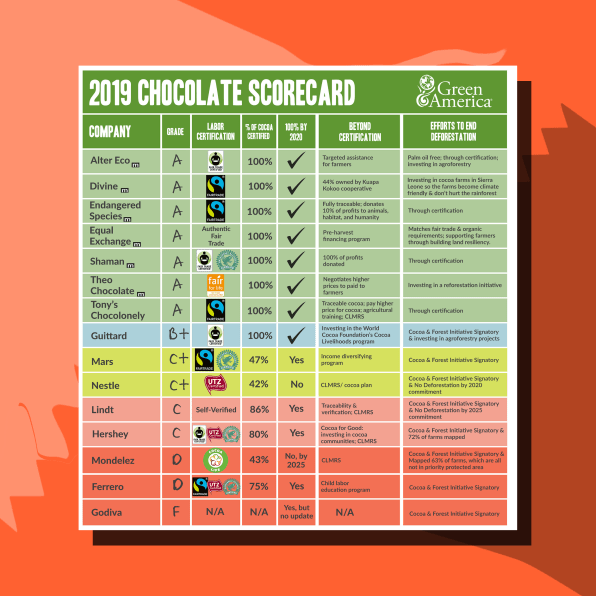See which Halloween candy is contributing to child labor and deforestation
Deciding what candy to give at Halloween can be a difficult choice. Do you want to be a Mounds person or an Almond Joy person? Do you want to give out raisins (hopefully not)? But if you decide on M&Ms or Butterfingers or even the cheerfully named Mr. Goodbar, you might be doing something pretty scary.
Those treats all come from major chocolate companies—Mars, Nestlé, and Hershey, respectively—that still have less than ideal protections in place to prevent child labor abuses in the countries they source cocoa from, according to a new audit from Green America, a nonprofit that focuses on encouraging environmentally friendly and socially just buying behaviors and business practices.
In time for Halloween, Green America released the 2019 Chocolate Scorecard, which grades companies based on publicly available information about three criteria: their fair labor certification practices, other community empowerment initiatives beyond basic certification, and their efforts to end deforestation. Mars and Nestlé received a “C+” while Hershey received a “C.” The only company to completely fail was Godiva.
Green America’s top scorers, meanwhile, are less recognizable brands, though you can still find them at most U.S. grocery stores: Alter Eco, Divine, Endangered Species, Equal Exchange, Shaman, Theo Chocolate, and Tony’s Chocolonely all earned an “A” grade.

As the Washington Post reported in June, America’s top chocolatiers have publicly pledged for decades that they’re working to stop child labor practices. Yet more than 2 million kids are estimated to be working in cocoa fields in West Africa. “We hope to put the scorecard out far enough in advance that consumers haven’t bought their Halloween candy yet,” says Charlotte Tate, the labor justice manager at Green America. “And then they can use of scorecards to purchase Halloween candy from more ethical brands.”
The group hopes that pressure may be enough to encourage more change at many of the still offending places: “It’ll start to show those brands that consumers do care and that may need to step up their efforts to address child labor and labor abuses and their supply chain,” Tate says.
Examples of basic fair labor certifications include Fair Trade International, Fair Trade USA, and Rainforest Alliance (which has merged with another organization called UTZ). Some companies like Mondelez and Lindt have developed their own criteria for self-certification but score lower because those processes are less clear-cut and independent. Beyond certification moves include efforts like Devine sharing ownership with farmer cooperatives in West Africa, so harvesters have a say in the practices they deploy. Top-scoring Alter Eco also doesn’t use palm oil in its products, a major contributor to deforestation, and invests in agroforestry practices to help maintain the environment where they’re planting.
Since 2015 Green America has traditionally ranked candy companies about twice annually, generally around our collective sweet tooth moments—the fall holiday seasons and in the spring, around Valentine or Easter. This year it added the environmental impact category, although it was done mostly to help consumers understand more about related troubling issues. It had a relatively small effect on overall scores. (In response to the scores, Hershey’s and Mondelez noted the work they’ve done on their own responsible sourcing initiatives. The other companies didn’t respond, but we will update this article if they do.)
“Within the cocoa industry there seems to be an intersection between labor abuses and environmental practices,” says Tate. “So, for example, within the Ivory Coast and Ghana, 90% of their forest has been lost to the cocoa industry.” A big reason is that cocoa trees need to be replanted over time, and that costs money, especially if you’re trying to replenish the nutrients in the surrounding soil. When farmers are paid too little, they can’t afford to do that. “So instead they expand into forest areas, which obviously causes deforestation,” she says.
Companies that have made long-term commitments to change business practices might still score low if they’ve yet to disclose progress toward those goals. “We’ve seen companies announce initiatives where they’re gearing a hundreds of millions of dollars toward the problem . . . [but] we need to see what the results of those initiatives are,” says Todd Larsen, the executive co-director for consumer and corporate engagement at Green America. “We have seen the large companies taking this issue a bit more seriously in the last couple of years, and I think part of that is the consumer awareness and attention.”
(58)



